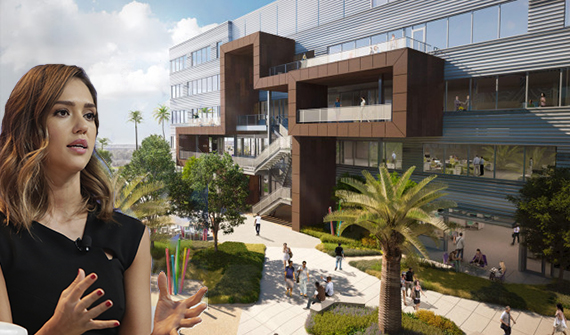Trending
In LA’s office market, is there trouble between the spreadsheets?

While thousands sweat to Beachbody’s at-home workouts, the Santa Monica-based startup is doing some perspiring of its own — hoping to jettison the 69,000 square feet it gobbled up less than a year ago.
After expanding its lease in May 2016 to take over the former Imax Building at 3003 Exposition Boulevard in the Lantana Entertainment Media Campus in Santa Monica, Beachbody is looking to shed the space and consolidate at its 131,000-square-foot headquarters.
The sublease space was meant to house the company’s tech team, a key component of the firm’s steady revenue growth over the past nine years, according to JLL. But like a growing number of hot tenants in the Los Angeles area, Beachbody is cutting the fat. Peel back the layers of good news that came out of fourth quarter office reports, including record absorption and investment, and there are signs that trouble is brewing — namely a sprouting sublease market.
Large tenants from Warner Music Group and Kite Pharma helped drive the 2.1 million square feet of positive net absorption seen in Greater Los Angeles in the fourth quarter — the most in a quarter since 1998, CBRE data show. The activity helped L.A.’s office vacancy rate fall to 13.3 percent from 15 percent.
But amid the warm tidings of dropping vacancies are a growing number of vacant sublease spaces. In fact, sublease space availability has not been this high in six years, according to Transwestern.
“At year-end 2016, there was approximately 4.1 million square feet of office space available for sublease, both vacant and occupied, which was a 9 percent increase from year-end 2015 and up 42 percent from year-end 2014,” said Michael Soto, a research manager at Transwestern. “This is the highest amount of available office sublease space since 2011.”
A wave of mergers and acquisitions have resulted in firms consolidating their real estate, with some firms exiting L.A., Soto said. The aerospace, financial services and legal sectors, in particular, have seen notable shrinkage.
Volatile startups are also a major factor in sublease availability, as companies quickly expand and contract, Soto said. Nasty Gal’s 50,000-square-foot space in the PacMutual building, for example, was seen as a watershed moment for DTLA. But the company, which sells vintage clothes and accessories, has put up 14,600 square feet of that space for sublease since it filed for Chapter 11 bankruptcy in November 2016. Bankruptcy court documents show the company owed more than $5 million at the time to Callahan Capital for the lease on its DTLA headquarters, which runs through April 14, 2021.
In DTLA’s central business district, 2016 wrapped up with an overall vacancy rate of 20.4 percent, by far the highest vacancy rate in greater LA. About 1 percent of that vacant space, or 55,000 square feet, is available for sublease.
While that may not seem like much, the sublease market can serve as an indicator of where the overall market is heading. And it’s worth noting that available sublease percentages are higher in the Tri-Cities (1.1 percent), the Westside (1.6 percent) and Santa Monica (1.7 percent), according to Cushman & Wakefield data.
In the Westside’s tech-haven Playa Vista, several media darlings are becoming more prudent and slashing their spaces. Jessica Alba’s The Honest Company, for example, is subleasing 19,000 square feet at its Playa Vista headquarters at 12130 Millennium Drive, sources told The Real Deal. Advertising agency 72andSunny is trying to sublease 19,000 square feet in the neighborhood too, the sources said.
Both companies gobbled up space too quickly, but with growth prospects no longer as strong as they were a year ago, are having trouble digesting it, sources said. In the case of Honest Company, Unilever’s $1 billion buyout offer that didn’t go through might have had something to do with it.
In the Tri-Cities area, available sublease space grew to 1.1 percent in the fourth quarter of 2016 from .6 percent in the first quarter of 2016, Cushman data shows. In the San Gabriel Valley, sublease vacancies rose to .6 percent in the fourth quarter from .4 percent in the first quarter.
This sublease growth could be a harbinger of a slowing office market in 2018 and 2019 — about the time 2.2 million square feet of office construction comes online in greater LA area, said Eric Kenas, research market director at Cushman.
For the first time in years, some industry experts are tracking the difference between direct vacancy and overall vacancy in an effort to parse activity in the sublease segment.
“The increase in sublease availability isn’t an issue as long as leasing activity remains steady,” Transwestern’s Soto said. “But any slowdown in office leasing activity — and subsequently, net absorption — combined with a continued rise in available sublease space will affect the office market adversely with rising vacancy levels and downward pressure on rental rates because of the competition of cheaper sublease space on the market.”
As more sublease space has hit the market, overall vacancy in L.A. has held steady the past two quarters, hovering around 14 percent with a short hop that closed out the year at 14.1 percent. In DTLA, vacancies leveled quarter over quarter with the LA metropolitan area at 13.1 percent, which is reassuring news — for now.
Hannah Miet and Katherine Clarke contributed reporting




